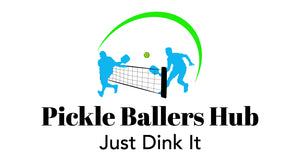How to pick the best PIckleball Paddle for yourself by PickleBallersHub.com
Pickleball isn't all about reflexes, your paddle does half the work. Choosing what pickleball paddle to pick might make you feel completely lost, and a lot of people feel like that too. The truth is the best paddle is different for everyone. The first step is recognizing what kind of player you are. Two players with equal skill can go against each other, but the one with the right paddle will always win.
So how do you choose the right paddle for you? Everything from playing style to skill level should be taken into consideration. Are you more likely to be aggressive at the net, using raw power? Or are you a controlled, precise, defender? Or are you a balance of both. If you are ready to start shopping, checkout our Pickleball Paddles.
Choosing the right pickleball paddle to match your game
When considering shape and size, not all paddles are shaped the same and that's not just for looks. The “all purpose”, a standard body pickleball paddle, is the most common shape, and is best for beginner-intermediate and casual players.
Wide body pickleball paddles are, of course, wider, and another awesome beginner paddle They allow for more forgiveness just in case you don't hit that sweet spot.
Elongated pickleball paddles is where we see more single players in action. Unique for that long shape and perfect for players who cover a lot of ground. Elongated pickleball paddles also compliment a player who knows their way around the court, given its smaller sweet spot. While elongated pickleball paddles are less forgiving, the upside is they are more rewarding so when you hit that shot just right it will pay off.
Pickleball Paddle Weight Explained: Light Vs Heavy
If you prefer smashing shots, you might like a heavier paddle which would be a weight around (around 8.5–9.5 ounces). On the other hand a lighter paddle (6.8 - 7.8 ounces) might suit you more if your style of play is all about that precise placement. If you feel like you fall in the middle of these two, like most of the pickleball population, then you would probably feel most comfortable with a medium weight (7.8–8.2 ounces).
Choosing the Right Grip Size for Comfort and Control:
Although grip size makes playing more comfortable, there is more evidence that supports the benefits of looking into grip size. A grip that's too small forces your forearm muscle to overwork.
On the other hand a grip that's too large reduces wrist mobility, making it harder to generate spin or even adjusting quickly at those close exchanges at the net. Most players fall between the medium size which is about (4.25”–4.375”).
Smaller grips (4.25–4.375”)make adding spin easier and quick wrist action, while larger grips 4.5” or more have more stability. The key is just making sure it feels natural in your hand
The Science Behind Picklball Paddle Cores
The core of a pickleball paddle isn't just filler, everyone is engineered to give you a different feel and hit.
Polymore pickleball paddle cores are most popular because of their ability to absorb sound. Additionally a person with a joint problem might choose this one, because of the honeycomb structure, it can dampen vibration and cause much less strain on the wrist and elbow.
Nomex pickleball paddle cores are another choice more advanced players might choose, most likely because it rewards aggressive plays with more ball speed. However this means the paddle is less forgiving and its ability is mostly brought out by players who really know what they are doing.
Aluminum pickleball paddle cores are much lighter, and known for distributing impact across the paddle evenly, producing a softer steadier feel.
How Pickleball Paddle Affects Spin
Spin has become a gamechanger in competitive pickleball, and one thing that affects that most is texture of your paddle. A smooth texture is most likely to be on a beginner paddle, and that is for good reason.
The texture is more predictable, and easier to learn with. In comparison, a textured pickleball paddle adds grip to the ball, spinning it as it makes contact, creating topspin and slice.
The choice comes down to playing style and skill, with smooth texture favoring control and textured paddles adding spin that can be unpredictable to your opponent.


